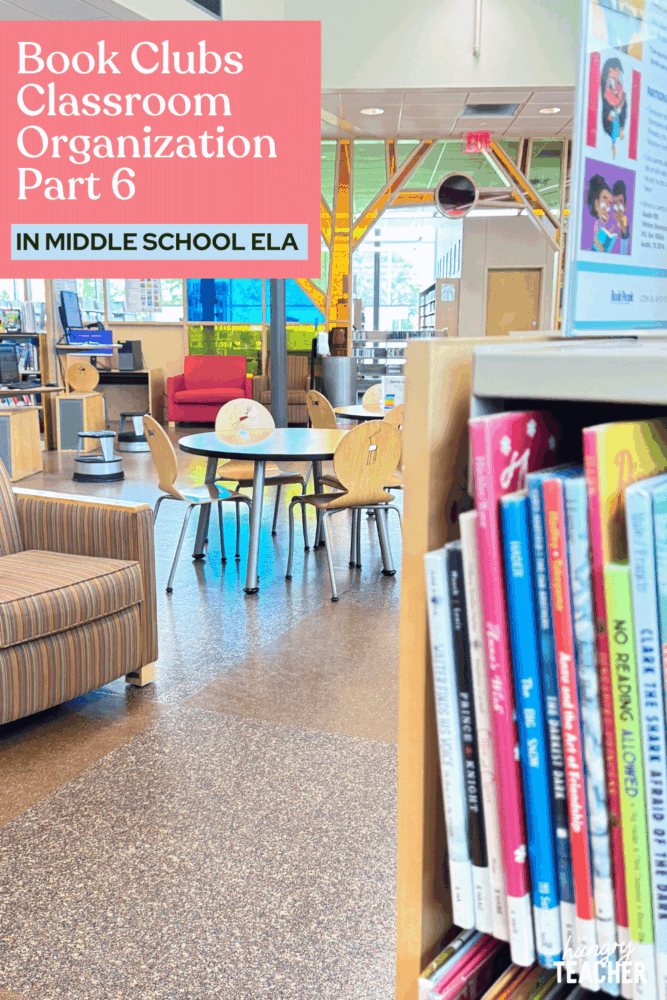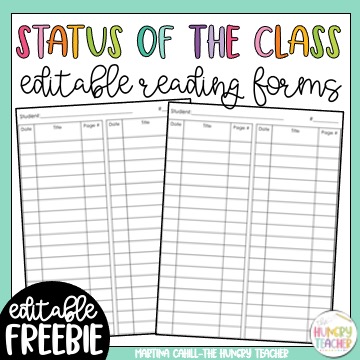hey friend!
I'm Martina.
I provide practical, time-saving strategies that actually work—so you can engage your students, teach effectively, and reclaim your time from the exhausting planning-grading cycle.
Browse Our ELA Resources
Book Clubs Classroom Organization | Part 6
BOOK CLUBS AND LITERATURE CIRCLES
This particular book clubs and novel sets blog post is more about organization and storage of all the sets. I have two other blogs posts that are helpful when it comes to implementing book clubs in your middle school ELA classroom:
- Book Clubs in the Middle School ELA Classroom
- Starbooks Books Tasting for Book Clubs and Literature Circles
ORGANIZING BOOK CLUB SETS
This is the first organizational system I had for my book club sets. At this point, I didn’t really have to deal with class novel sets. I mostly did book clubs and literature circles with my fifth grade students.
When I taught fifth grade, we did Guided Reading by DRA levels, and it helped me to know the general levels of my 6-book sets for literature circles. I REALLY don’t believe in students knowing “levels” or organizing by level, but it made sense back then. My top shelf had all my sets that I had purchased.
Now that I teach older grades, I have a pretty good idea of general levels and just keep them in their sets.
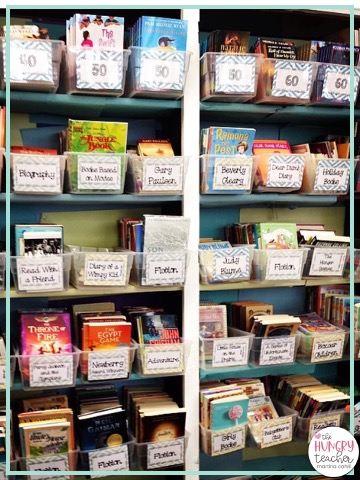
GETTING SETS OF BOOKS
Here is the most recent picture of my middle school ELA classroom library. You can see that my collection of book club sets has grown over the years. I get 90% of my book club sets from Scholastic Book Clubs. I can’t recommend Scholastic enough.
If you haven’t signed up for Scholastic yet, then you need to. I’m not always sure how their referral system works or if you need a coupon code, but sometimes if you use a referral code you can get extra bonus points. My name is Martina Cahill and my customer number is: 2177304983. I’m not positive if it will work, but it’s worth a shot!
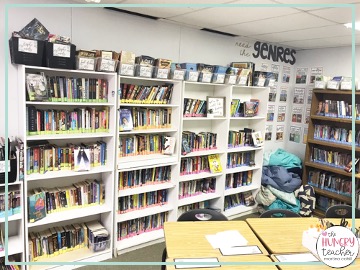
ORGANIZING SETS OF BOOKS
They bins are simply labeled as “Book Club Sets,” and any book that I have 4-10 copies of go together as sets in these bins. The students are 100% allowed to read any of the books that are up in these bins.
Most of the time, I have an extra copy of each of our book club books in our classroom library, but they are often checked out. I just remind students to put it back on top when they’re done.
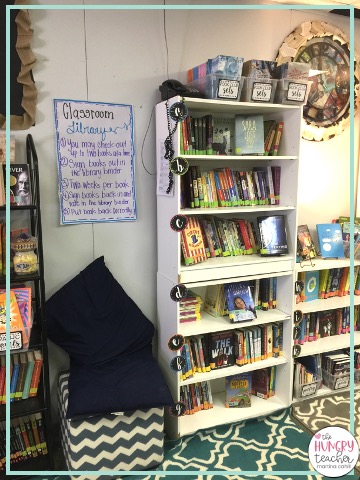
NOVEL SETS
When I was in self-contained in fifth grade, I tried to group them by DRA level. This was because we used the book clubs sets for Guided Reading too. When I was in sixth grade ELA, I had a mixture of genre based and DRA level based bins.

In general, I just wanted to have some DRA 34-44 books readily available for my RtI groups and more intensive instruction groups.
Truly, I think using books above this range in Guided Reading takes way too long to get through, and don’t really serve the needs of my students in those reading level ranges above 44 DRA anyway.
In my middle school ELA classroom, I don’t have a single label on any book. This is true for my classroom library, book club books, or book bins in my classroom.
First of all, I have 150 students, and there’s simply no way to accommodate that. Even more so, by middle school, if students haven’t figured out how to self-select books they like to read, then I think that becomes my most important job as their teacher. I use books clubs as one of my largest tools to continue to try and create life long readers.
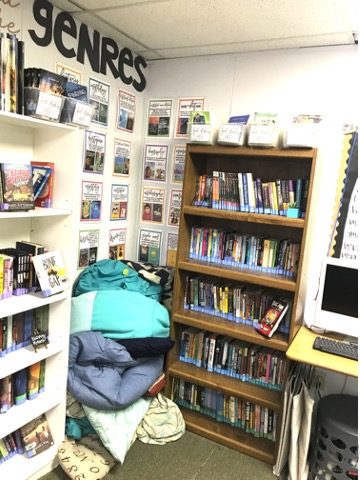
NONFICTION SETS OF BOOKS
Along with all the sets of book club books that are on top of the shelves in my classroom library, I also have a separate shelf in the back corner of my classroom that holds more of my sets.
I dream of having a separate non-fiction set of book club sets and some of these sets have started that collection, but I still have a long way to go in finding engaging non-fiction book clubs sets for my middle schoolers. The bins on bottom hide large anthologies and copies that we never use ha! I am always thinking about getting rid of them, but still working on if I am allowed to.
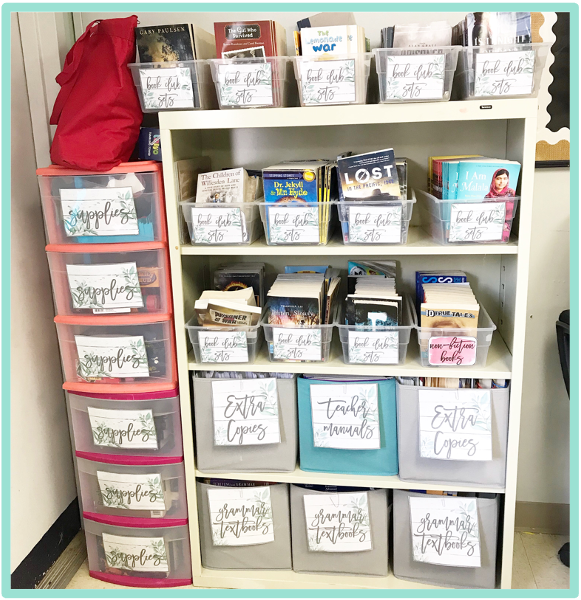
This is just a zoomed in picture of the book clubs sets, because I know I am always looking for new titles for my middle school students. I’m almost positive that all of these sets came from Scholastic Book Clubs. The only exceptions is A Long Walk to Water, which I actually have a class set of from a Donor’s Choose project I did.
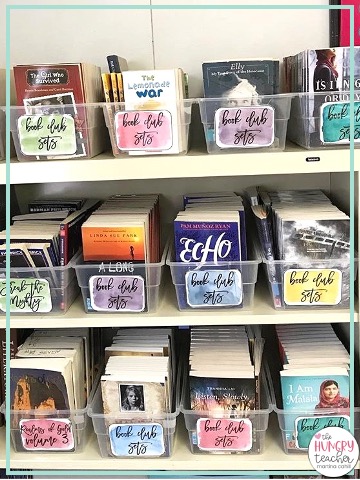
MAKING ROOM FOR BOOKSHELVES
This picture to the right is just a zoomed out view so you can see where by book clubs shelf is in my classroom, in relationship to the rest of the library.
I have a dream of having two entire walls filled with classroom library books and book clubs sets.
Only one more wall to go!
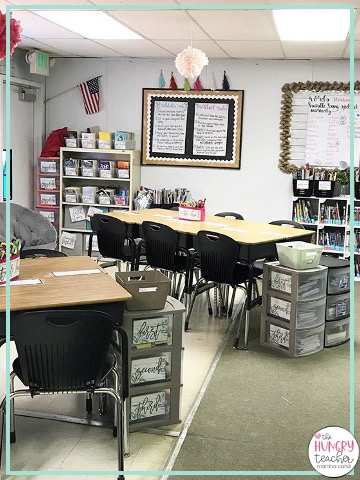
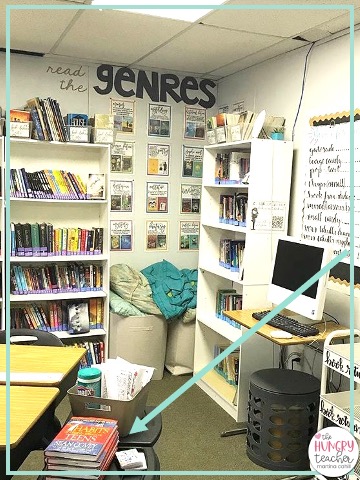
This image to the left has more to do with class sets of novels (which I am getting to soon) but it just shows you that sometimes our class sets just get set on top of the bins at the end of each pod.
We were reading parts of The Seven Habits of Highly Effective Teens in all four of my middle school English classes, and taking them in and out of bins every class period was honestly too time consuming (every class kind of shoved them wherever too). When ALL my classes are sharing a book, this system just makes more sense.
ORGANIZING BOOKS AND MOVIES SETS
I also use a lot of class sets for my sixth grade books and movies class. You can click here to read my blog post all about my books and movies class.
Although I am a seventh and eight grade ELA teacher but I do teach a sixth grade elective. It simply just doesn’t make sense to have all my sixth graders’ supplies with my seventh and eight graders’ supplies. My elective typically only has 14-18 students. The class period is also twenty minutes shorter than the rest of our class periods. Lastly, I only see each group every other day. We also do way less work in their notebooks and with their novels because of the time constraints. Plus it’s an elective, so it’s designed to be more laid back.
Because of these logistics, I keep all my sixth graders’ supplies pretty much completely separate from the rest of my students’. This was where I originally kept each class (6A was in the gray bin and 6B was in the teal bin next to it). I will talk about his more, but I keep all my sixth grade novel sets at home in bins and change them in and out as we read through books.
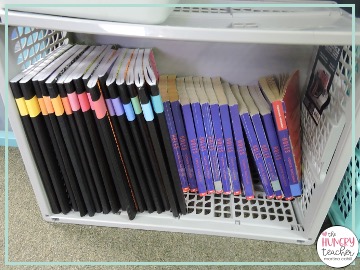
MORE BOOKS AND MOVIES SETS
Again, like many previous systems, as I was able to purchase more or move around more organizational shelves or containers, I adjusted to make them work better. I finally had an extra bookshelf for my 6th graders, so all their materials could go on these shelves.
My 6A class notebooks and current book/movie novel (The Maze Runner) is on the left side and my 6B class notebooks and book/movie novel (The Hunger Games) are on the right hand side.
I still change out books with the bins of books I keep at home to help maximize classroom storage. In books and movies, we read the book once a year, so it doesn’t make sense to store all those novels in my classroom all year long.
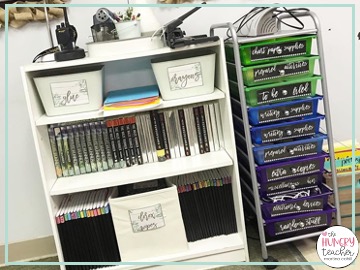
CURRENTLY READING NOVELS
I did make some changes to this set-up during my second year of teaching. The other was honestly fine, but I wanted all their notebooks away in drawers. Also, I finally purchased a second set of bins for each pod of desks. This allowed extra storage. We only needed bins fo four of my class periods.
We store 7th grade class novel sets in one and 8th grade class novel sets in the other. The two class periods of each grade share.

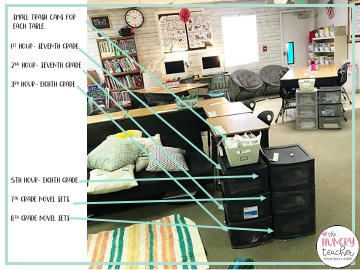
NOVEL CLASS SETS STORAGE
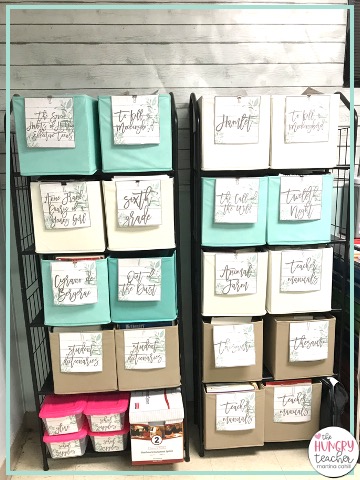
I’m not sure I will ever have the “perfect” system for organizing class sets of novels, especially in terms of aesthetics, but this is the first system I have actually liked and plan to use again. Every other system has never lasted me more than a school year. These fabric bins are just about everywhere in stores. I can fit a whole class set in one bin. I don’t have a single piece of storage in my classroom (which I know is not uncommon in many classrooms). All storage has been brought into my classroom in the form of bookshelves and bins.
If I ever had storage with doors, my class sets of novels would 100% be put away. Until then, they are in these storage bins on these shelves.
This is just a more recent picture. The shelves aren’t together anymore, and I’ve adjusted even more since this, but the whole idea is that this is the only system that has stuck. More than anything, It just makes my class sets of novels not look so dang ugly and the novels don’t take up as much room.
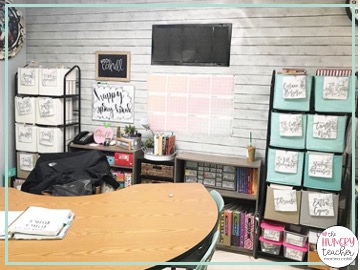
LARGE STORAGE BINS FOR CLASS SETS
This was my original solution to all my class sets of novels. It worked for the time being because I already had the bins (I had just moved across the state) and I was able to put multiple sets of novels in each bin. This system at least got them out of they way. That being said, having multiple sets in a bin also wasn’t ideal. When I would take a new set out to read, I would put the set we had just finished in whatever new space was empty.
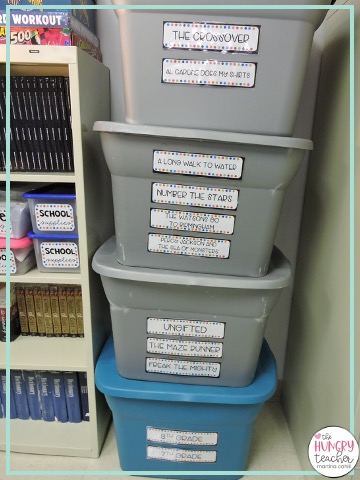
Basically the labels became meaningless. Anyway, I have two types of class sets now. I have the ones my curriculum and school require me to read with students. Those stay in the fabric bins at school. Most of these pictured here are novel sets I have purchased on my own. These bins are actually still used, but they are in my basement at home, holding class sets. I do use a lot of them with my sixthh graders during our books and movies class. I also will use them for book clubs. It’s easy enough for me to transport what I need, when I need it, without taking up valuable space in my classroom.
IMPLEMENTNING BOOK CLUBS
First and foremost, I try to make Book Clubs as simple as humanly possible.
I used to be MUCH more involved in the book clubs when I taught fifth grade, but I only had 24 students then, and I had them all day long… and well, they were in fifth grade. I used the book clubs to support them and teach them as readers.
Now that I have progressed to seventh and eighth grade English, my procedures and management have most definitely changed.
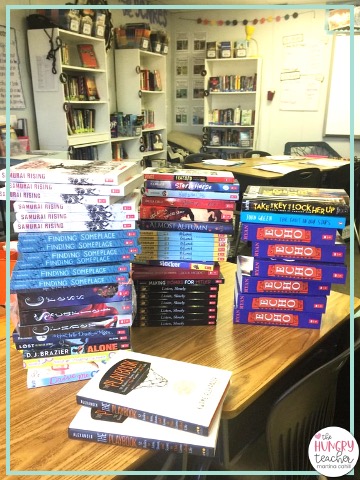
I’m going to keep it as real as humanly possible, because when I first started looking into implementing book clubs at this age, I wanted the real truth.
The following sections are the realities of what I have learned about book clubs.
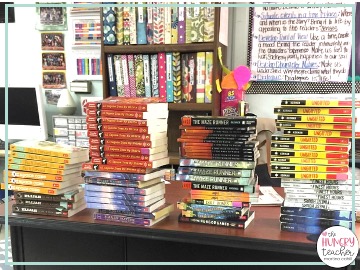
PUTTING STUDENTS INTO GROUPS
I don’t do it by reading levels. GASP. Honestly, I think that totally ruins the whole point of book clubs. My book clubs are done by 90% interest. I briefly show students ALL the options, my personal opinion of the book, who tends to like it, it’s genre, and subject. Then they can walk around and look at them all. Then they have to give me their top five choices for book club books. It used to be three, but now with 100 students, I had to go to top five, but I also have A LOT more book club choices.
PUTTING STUDENTS WITH FRIENDS
I try really hard to put them with their friends. 90% of the time this works in my favor because friends have the same interests and hold each other accountable… the other 10% are a complete disaster, but I can usually predict that. Sometimes I have kids that I know will make a book club difficult no matter which one I put them in. Not being mean, promise. Some kids just struggle with book clubs. I tend to put those 2-3 students in a book club together. Sometimes they set out to prove themselves and they have great success, or it’s a complete disaster. I always have at least one group like this, but I would rather it be one group than three or four that are a total disaster. So I just prepare myself and check in with them A LOT. If one or some end up proving themselves, they go to different groups next round, which is really what I want anyway.
TOP CHOICES FOR BOOK CLUBS
After students have given me their top five choices, I get to work making the groups. I almost always can give them one of their top two choices. Sometimes, due to not enough books, too many people in groups, or dynamics that doesn’t work. In that case, I do have to give them their third, fourth or fifth choice. I also gave my eighth graders priority.
FOCUS ON STUDENT’S READING STAMINA
Again, I don’t pay too much attention to reading levels, but I do pay attention to stamina. If I know a student struggles to finish books, I will push them towards books that requires less stamina. For example, if he/she has Divergent as an option, but also something like A Long Walk to Water (highly engaging, great book, but also short) then I will give them the shorter book. This is especially true for the first time to set them up for success.
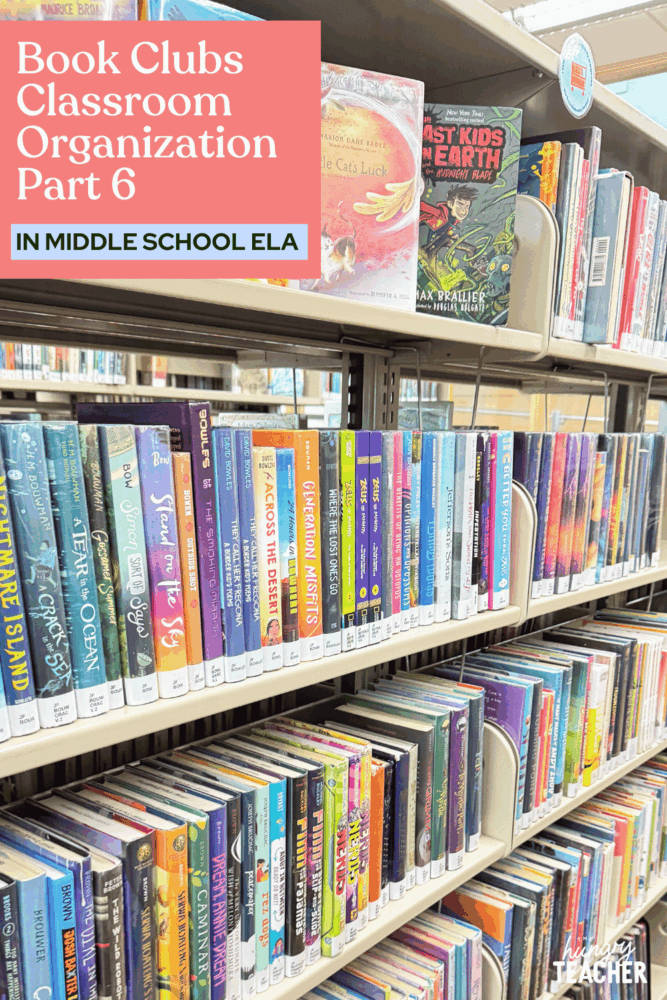
PREPARING THE CLASSROOM
This is honestly what my classroom looks like for a day or two when I am letting students choose their book club books.
I take all my book club sets off the shelves and place them down on chairs and desks so students can go through any that seem interesting to them. Students must pick their top five. I do five in middle school because I have 100 students and I need some flexibility.
They are warned from the beginning that they should truly like their top five because any of those five books are a possibility.
I try really hard to give them their top choices, but it just can’t always happen based on their interests or on what other students pick.
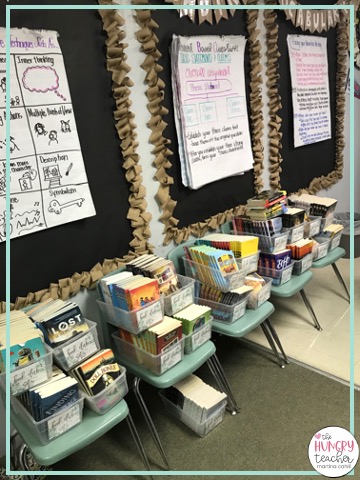
I also try to give my eighth graders a little bit of seniority, and form their books clubs first.
I try really hard to only have three-four kids per book club. If six kids want to read the same book, I honestly will split them into two groups of three. Sometimes they will kind of join and converse anyway, but I feel anything above four is beyond my classroom management abilities.
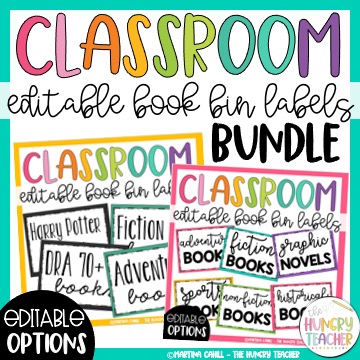
EDITABLE BIN LABELS
You can click here to get see all the different editable options.
THE GOOD, THE BAD, THE UGLY
Wait to do book clubs. My mentor teacher told me to wait at least six weeks into school. SHE IS MORE THAN RIGHT. When I was in elementary that was really hard for me to wait that long because I loved them and management was simple. In middle school, sometimes it hasn’t been until second semester, simply because I’ve had to wait until a point I thought they could handle it, and a point where I could manage it.
STUDENTS WHO DON’T DO THIER WORK
Some kids will NEVER read and will NEVER do their book club work or homework. Or they will pretend and make up the reading and/or homework. I wish I could tell you 100% of my students do their book club homework, but it’s just not reality. Personally, I REALLY do not want to give them quizzes, or comprehension activities, or just another thing for them to do. So I don’t. I want book clubs to be fun, and to provoke conversations, and to give kids common things and interests to talk about. The book club homework is something super simple and designed to help guide their discussions and 95% of the students do just that. I work really hard to get the other 5% to appreciate the process and idea as well. Some come around and some never do. I don’t give up on them, but just know that it does happen.
WHEN KIDS DON’T LIKE THEIR BOOKS
Sometimes kids pick books they don’t like, and want to quit. This is a tough one. If the whole group is on board after the first week, I will allow them to abandon and come to a new agreement for their book. If it’s just one student, I try to have a discussion with them and see what’s best for them and their group. Sometimes they abandon, move to another group and have to play catch-up. Sometimes they just have to suck it up. Again, it doesn’t happen often, but there are always a few.
WHEN STUDENTS READ AHEAD
Some people read ahead. I let them. As a class, we make super strict rules about no “SPOILERS.” If they read ahead, they need to review where their group is so they don’t reveal information later in the book. They also have to make sure they only do their “homework,” for that week’s reading. Who doesn’t want to read ahead when a book gets good? And four weeks is A REALLY LONG TIME for true readers. Often these kids end up in groups together, end up reading the whole book in a week. I usually tell them not to worry about the homework and just have discussions. They will devour 3-4 books during the span of 4 weeks… That is a huge success, in my opinion! I 100% let the book clubs evolve as they need to.
WHERE DO I GET ALL THE BOOKS?
I probably get this question more than anything. Honestly, I buy them all. I have been buying the sets for the last six years, but it’s more than worth it to me. This has built up a really solid collection for grades fourth through sixth, but then switched to seventh and eighth. Since then I have started to have to buy other sets to keep up with their interests and needs.
I could sit here and tell you that I scope out the best books and the highest quality of literature, but I have a couple problems with that thinking.
First of all, I’m not sure who get to decide what “quality” literature is, except the reader… so I don’t make the decision. Currently my new school has a big focus on “the classics,” so we’re getting plenty of that. Third, I just buy what I can get sets of.
Any time books go on sale for $1-$3 on Scholastic, I buy five to six copies of them. Over time, you have a pretty good collection of book club sets. Now that I have a solid collection, I focus on getting specific genres, interests to meet my current students’ wants, higher reading levels, and now I’ve put more of a focus on getting and some good non-fiction sets.
READING THE BOOKS
Also, I hate to break it to you, but you REALLY have to read the book club books that your students read.
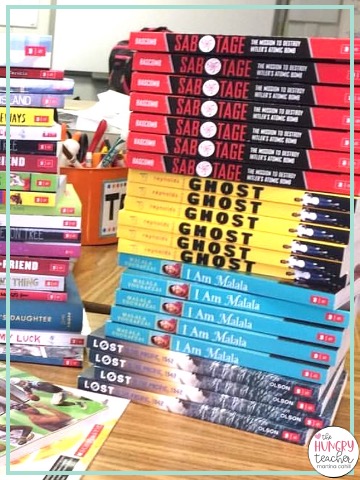
I have read 80-90% of my sets, and if a club picks a new book, then I make sure to read as they are reading. It’s not always easy, but it’s kind of necessary, because kids know when you haven’t read the book.
The exception is when you have a book clubs form naturally and you know the kids are reading. Again, this is the real goal of book clubs, and they don’t really need you too much anymore. Sometimes groups bring in their own books and do that for the club. 99% of the time, those self-motivated groups, do it all without me and that’s the best thing ever!
HOW DO YOU RUN BOOK CLUBS?
This changes constantly.
When I taught fifth grade, they decided how much they would read each week, they each had to come to the group with three questions to ask, we would meet (me included, to help run the groups and make them think deeply about the books), discuss the books and our questions, and then we would do it all over again.
In seventh and eighth, I have to have more structure, because I can’t meet with all my groups every week, simply because of time constraints. Also, they’re in seventh and eighth grade. So I would like them to truly be able to read the books they want, have conversations with each other, and see how book clubs really should be.
MAPPING OUT THE BOOK CLUB TIMELINES
Something that I learned from Erin Cobb (Lovin Lit’) that I loved, was a time frame for the books. She mapped out how long they had to read the books. For seventh and eighth, they had four weeks, and they just did the math themselves. They just divide the book’s number of pages by four so they could determine how many pages they had to read each week.
I also tell them about this before hand, so students who think they don’t “read fast,” know what is expected of them.
Then they are responsible for one “job” each week. I usually give them some type of packet that has four-five pages of jobs and they have to do one weeks’ reading and one page of the packet
After I teach my lessons, I then ask students what they are going to do, do a quick Status of the Class check. I simply ask them what they’re reading and what page they’re on. I write it all down, and they get started. While they work on these, I meet with my groups. This really helps me know which kids or book clubs I need to check in with.
You can get free, editable Status of the Class forms by clicking here.
I definitely do literature circles in so many different want but I do like to have forms for some groups.
When the pandemic hit, I also made sure to make digital versions, so students could still collaborate.
Click here or on the image to get the Literature Circle forms for middle school resource.
BREAKING DOWN BOOK CLUBS
Here is a broken down example: A group is reading, Al Capone Does My Shirts and they had to read sixty pages during week one.
Student One would be reading those sixty pages and be responsible for the “Discussion Director” for only those sixty pages.
Student Two would read the same sixty pages and be in the “Plot Profiler,” for those sixty pages.
The next week, they switch jobs for pages 61-120.
Here’s a better example of a groups weekly break-down.
- One: Read pages 1-60
- Two: Read page 61-118
- Three: Read pages 119-183
- Four: 184-237 (finish book)
One:
- Mariah: Discussion Director
- Richie: Plot Profiler
- Mackenzie: Illustrator
- Nico: Literary Luminary
Two:
- Mariah: Plot Profiler
- Richie: Illustrator
- Mackenzie: Literary Luminary
- Nico: Discussion Director
Three:
- Mariah: Literary Luminary
- Richie: Discussion Director
- Mackenzie: Plot Profiler
- Nico: Illustrator
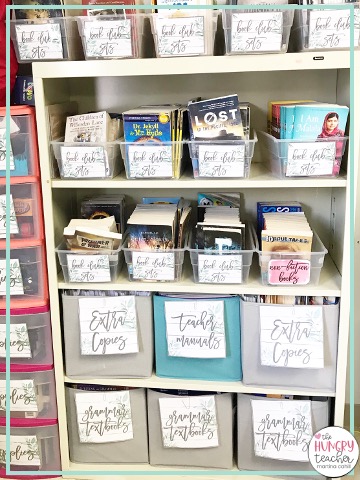
Four:
- Mariah: Illustrator
- Richie: Literary Luminary
- Mackenzie: Discussion Director
- Nico: Plot Profiler
GRADING MIDDLE SCHOOL BOOK CLUBS
This is such a tough one, because I don’t want to make reading something they hate, so I try to make it all about them and making sure they don’t let their book club down.
By making book clubs a really big deal and really selling the value and purpose of them (to enjoy books, and have conversations about books, with people who have similar interests) they kind of do the whole disappointed in their peers and classmates thing for me.
I do always have a group or a few who band together and act like they don’t care that none of them do the work and/or reading, but the rest of the class tends to think they’re lame, and don’t join in on their bad attitudes. Just keeping it real. It does happen, but when they all come unprepared, I just say, “That’s a bummer. Hope you guys do it next week so you can have a book discussion then.” Yes, even eighth graders.
ASSIGNING GRADES
BUT, I do assign grades for the work, simply because I’m a realist.
Students are responsible for reading 1/4 of the book and one page of their packet each week. I make it 25 points each week… for a total of 100 points.
The packet itself gets turned in at the end of the four weeks and becomes another 100 points. That way if they get behind, miss a page, or have a bad week, they have the opportunity to go back and complete the pages and earn a full 100 points on the packet. They only get the 25 points on the day books clubs meet (it’s automatically a zero, if they come unprepared, with no room to make it up, but they can and should do the reading and homework page later for when they turn in the packet). It’s kind of like a participation grade.
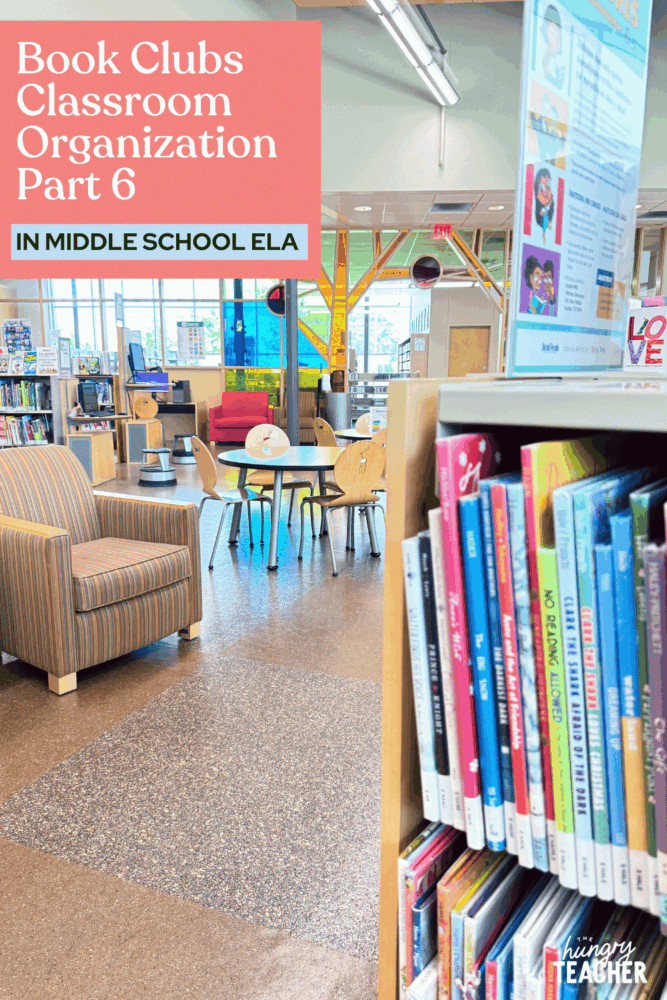
GETTING THEM TO COMPLETE THEIR READING
I do this so they complete the reading later and don’t get further and further behind, and because I think it shows their peers something if they mess up, but are willing to do the work to be back in the club.
If they come unprepared more than once, they are “kicked out” and have to finish the novel on their own and write an essay.There wasn’t a single student that missed work more than once because of this. I just walk around when they meet (all clubs meet on Mondays) and while they’re discussing, give them 0-25 points.
After they’re done meeting, I talk to my zeros and what they need to do for next week.
Want more help implementing book clubs in your classroom. I’ve taken everything I’ve learned over the years and created what has become my most popular workshop: Book Clubs in a Box.
This blog post is part eight of ten blog posts all about how I organize different areas of my classroom. Click on any of the links to be taken to each of the posts in the series:
- One: Lesson Planning and Lesson Materials Organization
- Two: Teacher Materials Organization
- Three: Student Materials Organization
- Four: Classroom Routines and Novels Organization
- Five: Classroom Library Organization
- Six: Book Clubs, Novel Sets, and Literature Circles
- Seven: Small Group Organization
- Eight: Grading and Assessment
- Nine: Long-Term and Short-Term Sub Planning
- Ten: Back to School Organization
CLICK HERE to get the Organization Overhaul Complete Classroom Course plus bonus resources for each module.
CLICK HERE to get the complete printable organization E-Book.
Get the Organization Overhaul Complete Classroom Course
Want a sneak peek at teaching The Hungry Teacher way—with support, structure, and strategy?
When you join the waitlist for The Hungry Teacher’s Hub membership, you get three free classroom-ready resources: a theme unit, an expository writing unit, and a grammar unit introducing mentor sentences. Plus, you’ll get immediate access to a selection of exclusives from the Hub, including editable sub plans, pacing guides, and more.
No strings attached. Just resources you can use right now—and a heads-up when the Hub opens.
3 Free Middle School ELA Units—yours to keep!
JOIN THE WAITLIST + A FREE GIFT
Where to next, line leader?
Welcome to The Hungry Teacher! We create resources that are easy to use, practical, and get results. Teach with confidence—and make it home before dinner.
xo, the hungry teacher
